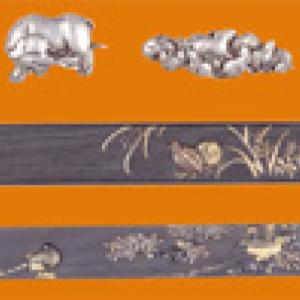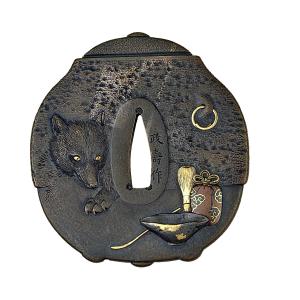Since the mythical beginnings of the archipelago's history, the Japanese sword (nihontō) has had deep spiritual and political-religious connotations: with the “mirror” (kagami, display case 2) and the curved “jewel” (magatama, display case 1), it is in fact one of the three symbols of imperial power and descendance from the sun god.
A precious and highly symbolic possession of the samurai, the sword was an emblem of his privileged social condition, a symbol of his soul and his most intimate identity as a man and warrior. The Japanese blacksmiths were custodians of a forging tradition dating back to antiquity: the first swords of the archaic era, called jōkotō (display case 9), coming from the burial mounds of the Kofun Period (ca. 300-710), were long, straight and single cutting edge (hira zukuri), they were carried hanging on the left side with the cutting edge facing the ground; the blades from the Nara period (645-793) and the first part of the Heian period (794-897) were also of this type.
The golden age of the ancient sword (kotō), between the eleventh and fifteenth centuries, includes the Fujiwara (898-1185) and Kamakura (1185-1392) periods and corresponds to the appearance and development of the tachi, a long sabre suitable for equestrian combat, with a slightly curved form and equipped with a tsuba - that is, an iron hand guard inserted between the handle (tsuka) and the blade: this element will, from then on, remain substantially unchanged. Accompanied by a short tachi (kodachi) or dagger (tantō) used in a melee and body-to-body, the tachi had become outdated at the beginning of the fifteenth century and, over time, its use became ceremonial, as in the case of the specimen exhibited in display case 9.
In fact at the beginning of the Muromachi Period (1393-1572), with the technique of footed combat, the katana, a sabre shorter than the tachi, which was worn tucked in the belt with the cutting edge facing upwards: this made it possible to unsheath and strike the blow with a single movement.
Soon the katana was accompanied by a second shorter blade, the wakizashi: these two weapons from then on constituted a “standard” combination "long and short blade" (daishō), whose possession was reserved for samurai from the beginning of the seventeenth century. The third and last evolutionary epoch, that of the new sword (shintō), extended from the Momoyama (1573-1603) to the Edo period (1603-1868): it coincided with a prolonged era of peace which favoured the decorative development of the various constituent parts the sword frame, including the elements of the hilt (kodōgu) and the scabbard (saya). Warriors, unable to exercise their profession due to the political peace, occupied by continuous ceremonial and representational obligations, concentrated their attention on the ornamental aspects of the frame and its various component parts.






